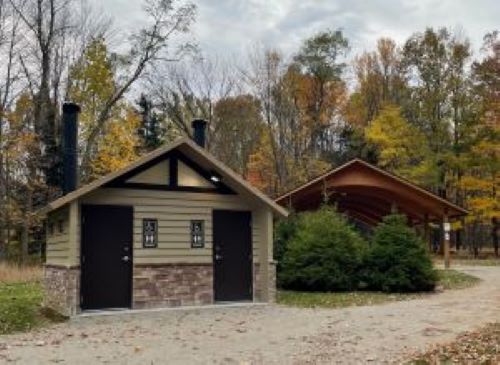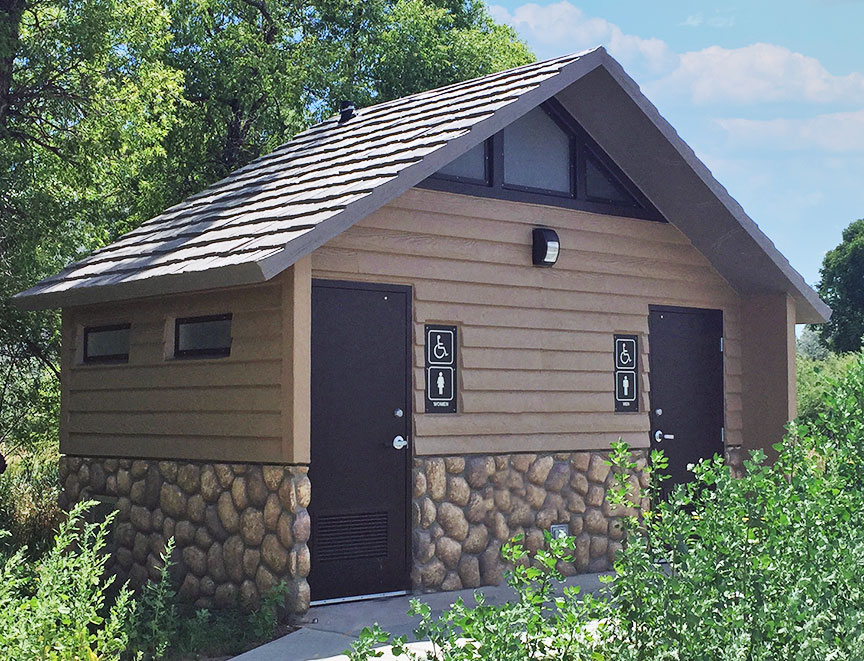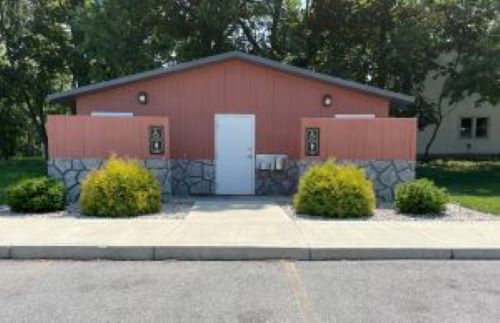Restroom Structures Make Sites More Welcoming
When you gotta go, you gotta go. And if there’s nowhere to go, you’re not going to hang around. Add young kids with potty emergencies to the mix, and there’s no question about it: Your park needs restrooms—especially if it’s a home to playgrounds, sports fields and any other amenity that encourages folks to stick around a while.
“Restrooms add a necessary convenience for families and allow visitors to spend more time at the park,” said Hannah Duncan, marketing and communications director for an Oregon-based manufacturer of structures, including restrooms.
In fact, the National Study of Playgrounds, an observational study of 60 playgrounds in 10 major U.S. cities that compared the impacts of design on activity and play behavior, conducted by nonprofit Studio Ludo, found that playgrounds with restrooms located nearby saw 44% more users, and increased the likelihood of staying longer by 48%.
“Simply put, having a restroom available serves a basic need for the public and your park patrons, especially children and parents,” said Kristyn Young, director of marketing and planning for a restroom manufacturer based in Reno, Nev. “If there’s a playground involved, many people expect to have a restroom available nearby and for good reason: children are unpredictable.”
She added that providing restrooms “… helps reduce instances of people finding their own place ‘to go’ within your park, which creates other problems and public health concerns. Just as we expect park patrons to pick up after their dogs, we should have a designated spot for humans to relieve themselves as well.”
According to Gregg Zentarsky, a sales manager for a manufacturer of precast concrete products, including prefab restroom structures, with offices and manufacturing facilities across the U.S., “The overwhelming majority of complaints parks and recreation departments will hear when surveying their park-goers is the age and cleanliness—or complete lack—of restroom buildings.”
He added that safe and clean restrooms also encourage patrons to do their part to keep the rest of the park clean and free from vandalism.
In short, while it can be a budgetary and staffing challenge, adding restrooms to your parks makes those locations more welcoming and inclusive to visitors of all ages and abilities. Ready to get started?
If You Build It…
“The most important factor in adding restrooms to a park,” Duncan said, “is the budget. What does the budget allow for the site, and what are the priorities for that site based on budget?”
Knowing your budget, there’s a lot more to consider as you get started on your restroom project, whether you’re building a brand-new park or just looking to make your existing park more inviting.
For new parks, determine the general size of the park and what the park offerings are going to be (playground, sports fields, splash pad, etc.),” Young said, “If people will be spending more than an hour, adding a restroom is probably a good idea. If it’s an established park, figure out usage during peak times so you can plan your restroom size accordingly.
Once you understand peak usage,” she added, “you can decide what is needed in terms of restroom size and if you should add extras to the building like storage, concessions and/or exterior showers. The fun part is always the last steps—designing the building’s overall look and feel by selecting features and finishes to match the existing landscape.
While you can start from scratch and work with an architect to design park restroom buildings, that can be a time- and budget-consuming process. Premanufactured restrooms can help whittle that down, with vault options available for sites without utilities, and plumbed structures available that can be dropped in place with minimal sitework.
The Wake of COVID
As the coronavirus pandemic rolled across the American landscape in 2020, citizens were advised to maintain safe distances from others, cover up with masks and keep their hands clean. As more people headed outdoors to socialize more safely in the fresh air, some restroom manufacturers saw an uptick in requests for things like touchless features and hand sanitizer—and those requests have not necessarily abated.
While Zentarsky said his company has not seen an increase in the number of touchless features being requested, Duncan and Young both said clients are commonly requesting such amenities now.
“Touchless and motion sensor fixtures have certainly grown in popularity, as well as hand sanitizer,” Duncan said. “Many restrooms now carry both hand sanitizer and soap and water.”
Sensor-operated fixtures like toilets, sinks, hand dryers and soap dispensers “…have become a common ask for new restrooms,” Young agreed. “Touchless fixtures reduce the number of common surface areas that people touch and ways to exchange germs.
“Another feature that we encourage our customers to implement is natural ventilation through maximizing vent screens,” she added. “It seems like a very simple idea, but one of the best ways to reduce airborne pathogens is nature air flow.”
Evolving Designs
While COVID may have had a small impact on the ways restrooms are being designed, other trends have taken hold that are making facilities more friendly for park visitors—and for park owners.
The most recent trend in the industry, Zentarsky said, is for restrooms to be designed as single-user, non-gender-specific spaces.
Young agreed. “Over the last few years, it’s more common for customers to choose single-occupant layouts over multi-occupant. There are a lot of reasons behind this, but a driving force is to have restrooms that are non-gender-specific and can accommodate anyone.”
Another trend, she said, adds storage space to the building, making it “multifunctional for park management.”
She added, “It’s common for parks to have large grass areas and maintenance equipment, so by having a dedicated storage room, you can keep everything stored on location instead of having to transport to and from. Another great reason for storage to be added is so that cities and towns can offer summer camps at park locations, allowing everything to be easily stored and accessed by camp counselors.”
Duncan sees another arrangement becoming more popular: restroom/pavilion combination buildings. “These structures provide the convenience of restrooms along with a shaded space for families to enjoy a picnic lunch or host a child’s birthday party,” she said. “It just makes sense to put these amenities into a singular structure. It saves the owner money on design and construction.”
Other trends involve the amenities that go along with the restroom. Young said that adding drinking fountains and bottle fillers is a popular feature these days. “Post-COVID, parks in general have experienced a huge uptick in usage, and providing water is just another added convenience to your park patrons—especially at trailhead locations.”
Zentarsky added that timed locks are another common request. “Parks utilizing timed locks on their restrooms allows their buildings to unlock and lock at prescribed times without the need for employees to open and close their buildings,” he said.
Mischief Managed
Restroom buildings are commonly subjected to vandalism and graffiti, and this is another area where those timed locks can help, Zentarsky said. “Door locking systems can be used that allow the building to lock itself at a prescribed time, then unlock in the morning,” he explained. “This can help keep late-night vandalism to a minimum.”
Beyond locks, Duncan said her company has worked with customers to suggest the best options based on the specific issues of their site. “The best way to prevent damage is to design with vandalism in mind,” she said. To that end, they offer “vandal-proof designs” including “…restroom layouts designed to eliminate doors, include concrete block partitions instead of the standard metal partitions and more.”
Because vandalism is not an uncommon problem for restrooms, Duncan said that restroom manufacturers are well aware of the best products for preventing problems. “When it comes time to design a new restroom building, talk to the representative and make sure they know that a vandal-resistant design is a top priority.”
“Keep it simple and get creative,” Young advised. “Vandalism is certainly a reason that discourages municipalities from installing public restrooms, which is why we only use certain fixtures and materials in our buildings. By choosing stainless-steel, penal-grade fixtures (toilets, urinals and sinks) without exposed plumbing, you’ll be able to keep the restroom area tidier, have less things to be broken, and it also makes it easier to clean floors.
“Other creative ways to deter vandalism would be implementing green screens on the exterior of the building, so the walls are covered with green, living plants, which helps deter graffiti. When designing a new park restroom, choose materials that are high quality and work for the surrounding environment.
“By spending the money up front on quality doors, fixtures, locks—you’ll save yourself money down the road by reducing repairs and maintenance while saving yourself a major headache too.”
A Place to Go—And More
Ultimately, adding a restroom building makes it easier for people to enjoy your park—especially elderly visitors and families with children. But Young said that it can do so much more.
“Remember that your restroom building can be more than just a restroom,” she said. “Installing a building that services multiple purposes makes a lot of sense, especially for parks that have sports fields or a splash pad. By adding storage, it makes routine maintenance easier for park staff and for any summer camp programming. By adding exterior showers, you can offer park-goers a place to wash off if near a beach or a splash pad. By adding concessions, you can create an additional revenue stream and offer snacks and beverages to spectators if you have multiple sports fields.”
“These days, parks can be a driving factor for growth in a community,” Duncan said. “When an area has a strong offering in parks and recreation this can be an appealing factor for young professionals. If you want to see growth in your area, start by providing a robust culture around parks and recreation, which includes providing restrooms and recreation sites.” RM
All photos provided by CXT Inc.




